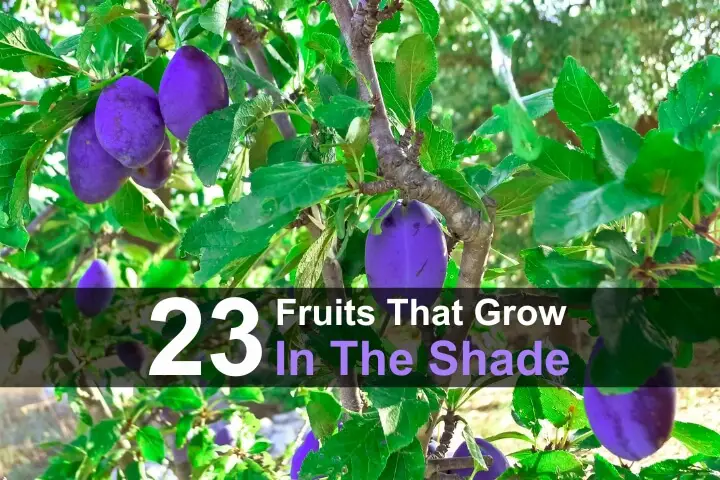23 Fruits That Develop In The Shade

Estimated studying time: 18 minutes
Once I purchased my home, I particularly purchased one with a really shady yard. It is a big yard surrounded by tall oak timber, and I needed the shade due to how scorching it will get in the summertime the place I stay. Sadly, this was earlier than I bought into gardening, so I did not understand that just some years later, I might be cursing the very timber that made me need the home within the first place.
Fortuitously, I’ve achieved some analysis and found that there are all types of crops that may do pretty nicely within the shade, and even higher if they will not less than get just a few hours of daylight. If in case you have a yard that’s shady as a consequence of timber, excessive fences, tall hedges, or massive homes or buildings, I really feel your ache. That will help you out, I created an inventory of fruits that may develop within the shade.
A few of these shade-tolerant fruits may shock you, and there are lots of you have in all probability by no means even heard of. Whereas a few of them do not style nice eaten uncooked, you may nonetheless use them in jams, desserts, and lots of different recipes. Now let’s get onto the listing. Listed here are 23 fruits you may develop within the shade.
Notice: Most of those fruits nonetheless require not less than a pair hours of daylight, which is why it is best to measure solar publicity in your yard.
Wish to save this put up for later? Click on Right here to Pin It On Pinterest!
Black Chokeberries

Black chokeberries are small, darkish fruits that develop on shrubs in North America. These shrubs are fashionable for his or her hardiness and skill to thrive in a wide range of circumstances, together with poor soil and partial shade. Additionally they present decorative worth with their spring flowers, vibrant autumn foliage, and clusters of shiny black fruit.
Chokeberries are full of antioxidants, nutritional vitamins, and fiber, making them a improbable addition to a nutritious diet. Whereas too astringent to eat uncooked, they will exchange cranberries or blackberries in recipes like jams, jellies, syrups, and baked items. Their distinctive tartness additionally lends itself nicely to creating juices and wines.
Black chokeberries do nicely with as little as 3–4 hours of daylight a day.
This is the right way to develop black chokeberries.
Blackberries

Blackberries are a basic fruit that grows on thorny brambles, producing juicy, sweet-tart berries which are excellent for snacking, baking, or preserving. These vigorous crops are extremely hardy and adapt nicely to a wide range of rising circumstances, together with partial shade.
Blackberries are extremely productive and versatile. Their berries are improbable in recipes like pies, cobblers, jams, and syrups, they usually make a terrific substitute for raspberries in most dishes.
Whereas blackberries produce finest in full solar, they will tolerate partial shade and nonetheless yield a superb harvest with 4–5 hours of daylight per day.
This is the right way to develop blackberries.
Chokecherries

Chokecherries are small, tart fruits that develop on shrubs. The crops are identified for his or her capability to thrive in a variety of circumstances, together with partial shade. They produce clusters of deep purple to virtually black berries, that are fashionable in conventional recipes and as a meals supply for wildlife.
These berries are value rising for his or her distinctive taste and flexibility. Whereas too tart to eat recent, chokecherries are wonderful in jams, jellies, syrups, and even wines. They may also be used as an alternative to cranberries in sauces and baked items, providing an identical tangy punch.
Chokecherries can thrive with simply 3–4 hours of daylight a day.
This is the right way to develop chokecherries.
Currants (Purple, Black, White)

Currants, accessible in purple, black, and white varieties, are small, juicy berries that develop on compact, deciduous shrubs. These fruits are prized for his or her tart taste and dietary worth, full of vitamin C and antioxidants. The crops themselves are stunning, they usually thrive in cooler climates and shaded areas.
Purple currants are excellent for jellies, sauces, and desserts, whereas black currants are sometimes utilized in jams, syrups, and drinks like cordials or liqueurs. White currants, the sweetest of the three, are wonderful for recent consuming or including a light tartness to desserts. They’ll additionally substitute for cranberries in lots of recipes, providing an identical tartness with a novel twist.
Currants can thrive with as little as 3–4 hours of daylight a day, although extra gentle will enhance yields.
This is the right way to develop currants.
Crabapples

Crabapples are small, decorative timber that produce tiny, colourful apples ranging in taste from tart to barely candy. These hardy timber are extremely versatile, thriving in a wide range of circumstances, together with partial shade.
Crabapples are excellent for making jellies, sauces, and ciders, in addition to for pickling or baking into desserts. Their tart taste makes them a superb substitute for conventional apples in recipes. They’re additionally a terrific supply of pectin, which is crucial for making jams and preserves from different fruits.
These timber can thrive with about 4–5 hours of daylight per day.
This is the right way to develop crabapples.
Elderberries

Elderberries develop on shrubs which are each hardy and fast-growing, usually reaching heights of 6–10 ft. The crops produce clusters of small, darkish purple to black berries, that are full of antioxidants, nutritional vitamins, and different vitamins.
The berries are extremely versatile, generally utilized in syrups, jams, wines, and natural cures as a consequence of their immune-boosting properties. They’re additionally nice for pies and baked items, and the flowers can be utilized to make teas, cordials, or fritters.
Elderberries are finest cooked earlier than consumption, as uncooked berries could be mildly poisonous. Their tart taste makes them a superb substitute for currants or blackberries in recipes that decision for a daring, tangy style.
Elderberry shrubs thrive with as little as 3–4 hours of daylight per day.
This is the right way to develop elderberries.
Goji Berries

Goji berries, also called wolfberries, are small, shiny purple fruits that develop on shrubs. These berries are full of antioxidants, nutritional vitamins, and amino acids, which is why they’re referred to as a superfood.
Goji berries are generally utilized in teas, smoothies, soups, and path mixes, providing a mildly candy and barely tart taste. They’ll exchange raisins or dried cranberries in lots of recipes and are simply as nutritious when dried as they’re recent.
Goji berries solely 3–4 hours of daylight per day to provide a wholesome crop.
This is the right way to develop goji berries.
Gooseberries

Gooseberries are small, spherical fruits that develop on thorny shrubs. They arrive in a wide range of colours together with inexperienced, yellow, and purple, and have a tart taste that sweetens as they ripen. The shrubs are compact, hardy, and extremely adaptable, making them a terrific selection for gardens with partial shade.
These berries are perfect for pies, crumbles, jams, and jellies, and their tartness makes them an ideal substitute for rhubarb in recipes. They may also be eaten recent when absolutely ripe or utilized in savory dishes so as to add a bit of tang.
Gooseberries thrive with simply 3–4 hours of daylight per day.
This is the right way to develop gooseberries.
Huckleberries

Huckleberries are small, spherical berries that resemble blueberries however have a extra advanced, tart-sweet taste. These native North American crops develop on low, bushy shrubs and are nice for cooler climates and partially shaded yards.
Huckleberries can be utilized in pies, jams, syrups, and baked items, very like blueberries. Their tangy taste additionally works nicely in savory sauces or paired with meats. Huckleberries are gradual to develop and sometimes take just a few years to determine, however their hardiness makes them a terrific selection for affected person gardeners.
These shrubs can develop and fruit with as little as 3–4 hours of daylight per day.
This is the right way to develop huckleberries.
Japanese Wineberries
Japanese wineberries are small, jewel-like purple fruits that develop on brambles with arching canes. They’re identified for his or her shiny, translucent look and sweet-tart taste. The crops are extremely decorative, with vibrant purple stems and a protecting of high quality hairs.
These berries are excellent for jams, jellies, pies, and syrups. They’ll exchange raspberries in most recipes, providing a novel tartness that balances nicely with candy dishes. It’s also possible to eat them uncooked in case you like.
Japanese wineberries thrive in partial shade, needing solely 3–4 hours of daylight per day.
This is the right way to develop Japanese wineberries.
Kiwi (Hardy Varieties)

Kiwi vines are vigorous climbers that produce candy, tangy fruits. Whereas the frequent kiwis require full solar, hardy varieties, equivalent to Actinidia arguta (hardy kiwi) and Actinidia kolomikta (Arctic kiwi), can tolerate partial shade.
Hardy kiwis are versatile within the kitchen, excellent for consuming recent, including to fruit salads, or mixing into smoothies. They may also be utilized in desserts, jams, and sauces, similar to conventional kiwis. The vines require a sturdy trellis or different assist system, as they will develop quickly and develop into fairly heavy.
Hardy kiwis can thrive with simply 4–5 hours of daylight per day.
This is the right way to develop kiwi.
Lingonberries
Lingonberries are small, shiny purple berries that develop on low, evergreen shrubs native to colder climates. These hardy crops are intently associated to cranberries and thrive in acidic, well-drained soil. Their shiny leaves and compact measurement make them a terrific selection for edible floor cowl, particularly in shaded or partially shaded gardens.
These berries have a tart taste much like cranberries, making them excellent for jams, sauces, syrups, and baked items. They pair nicely with savory dishes like roasted meats and may also be used as an alternative to cranberries in most recipes. Lingonberries are prized for his or her excessive ranges of antioxidants and nutritional vitamins, making them as nutritious as they’re versatile.
Lingonberry crops require solely 3–4 hours of daylight per day and may thrive in partial shade.
This is the right way to develop lingonberries.
Lowbush Blueberries
Lowbush blueberries are small, hardy shrubs that produce candy, flavorful berries. Native to North America, these crops are well-suited for cooler climates and are sometimes discovered rising naturally in forested or rocky areas. Their compact measurement makes them a superb possibility for floor cowl in edible landscapes.
These berries are scrumptious eaten recent and are excellent to be used in pies, muffins, jams, and smoothies. They may also be frozen for long-term storage or dried to be used in path mixes.
Lowbush blueberry crops can thrive with simply 3–4 hours of daylight per day.
This is the right way to develop lowbush blueberries.
Mayhaws

Mayhaws are small, spherical fruits that develop on timber within the southeastern United States. Resembling tiny crabapples, mayhaws have a tart taste and are sometimes used for making jellies and syrups.
Along with jellies and syrups, the fruit additionally works nicely in sauces, pies, and even wines. Mayhaws are a superb substitute for cranberries in recipes that want a tangy twist. The timber themselves are low-maintenance and supply extra decorative worth with their spring blossoms and shiny foliage.
Mayhaws can develop and fruit with simply 3–4 hours of daylight per day.
This is the right way to develop mayhaws.
Medlars

Medlars are small, brownish fruits that develop on compact timber. Usually thought of an old-world fruit, medlars have a wealthy historical past and are identified for his or her uncommon ripening course of, referred to as “bletting,” the place the fruit softens and sweetens after being harvested.
The fruit has a tangy, spiced taste and a smooth, virtually custard-like texture as soon as bletted. Medlars are excellent for making jams, jellies, and compotes and may also be utilized in baked items or eaten straight from the tree when absolutely ripe. The flavour is much like a mixture of apples and dates.
Medlars can thrive in partial shade with 4–5 hours of daylight per day.
This is the right way to develop medlars.
Mulberries
Mulberries are small, blackberry-like fruits that develop on timber. These fast-growing timber can thrive in lots of circumstances, together with partial shade, making them a superb selection for gardeners with restricted daylight.
The berries are extremely versatile and could be eaten recent, dried, or utilized in jams, pies, and syrups. Additionally they make a improbable addition to smoothies and may substitute for blackberries in most recipes. Mulberries ripen over an prolonged interval, offering a gentle provide of fruit slightly than a single harvest. This makes them nice for snacking straight from the tree all through the rising season.
Mulberry timber can produce fruit with simply 4–5 hours of daylight per day.
This is the right way to develop mulberries.
Pawpaws
Pawpaws are tropical-like fruits that develop on small timber native to North America. Also known as “America’s forgotten fruit,” pawpaws have a custard-like texture and a candy taste harking back to mangoes, bananas, and melons.
The fruit is scrumptious when eaten recent or utilized in smoothies, puddings, ice lotions, and baked items. Its creamy texture and unique taste make it a terrific substitute for bananas or mangos in lots of recipes.
Pawpaws are extremely shade-tolerant and may thrive with simply 3–4 hours of daylight per day.
This is the right way to develop pawpaws.
Persimmons

Persimmons are vibrant orange fruits that develop on stunning timber. Identified for his or her candy, honey-like taste, persimmons are available two important sorts: astringent (just like the Hachiya) and non-astringent (just like the Fuyu). Each sorts are extremely versatile and may thrive in partial shade.
The fruit could be eaten recent when absolutely ripe, dried, or utilized in a wide range of recipes, together with puddings, muffins, jams, and salads. Astringent varieties should be absolutely smooth to take pleasure in their candy taste, whereas non-astringent sorts could be eaten crisp like an apple. Persimmons can even substitute for mangos or peaches in desserts and smoothies.
Persimmon timber want about 4–5 hours of daylight per day to provide fruit.
This is the right way to develop persimmons.
Quinces

Quinces are aromatic, golden-yellow fruits that develop on small, decorative timber. Identified for his or her onerous, tart flesh, quinces have been cultivated for hundreds of years and have been as soon as a staple in European orchards.
Whereas too tart to eat uncooked, quinces shine when cooked. They soften and develop a candy, floral taste excellent for jams, jellies, sauces, and baked items. They’re additionally a basic ingredient in Center Jap and European delicacies, usually used to boost savory dishes. Quinces can exchange apples or pears in recipes, including a novel aroma.
Quince timber can thrive with simply 4–5 hours of daylight per day.
This is the right way to develop quinces.
Raspberries

Raspberries are a beloved fruit that develop on thorny canes, producing candy, juicy berries in a spread of colours, together with purple, black, yellow, and purple. These hardy crops are extremely versatile and thrive in lots of climates.
Raspberries are scrumptious eaten recent and are excellent for jams, pies, smoothies, and sauces. They’ll substitute for strawberries or blackberries in almost any recipe, providing their very own distinct, tangy-sweet taste. The crops are comparatively straightforward to develop and can reward you with a bountiful harvest every season.
Raspberries can tolerate partial shade, requiring simply 4–5 hours of daylight per day.
This is the right way to develop raspberries.
Serviceberries
Serviceberries, also called juneberries or saskatoons, are small, candy fruits that develop on small timber. These native North American crops are extremely decorative, with delicate white flowers in spring, vibrant fall foliage, and clusters of purple to blue-black berries in early summer time.
The fruit has a taste much like blueberries with a touch of almond and is scrumptious when eaten recent. It’s additionally preferrred for pies, muffins, jams, and syrups and may simply exchange blueberries in most recipes. Serviceberries are excessive in antioxidants and nutritional vitamins, making them a terrific addition to your weight loss plan.
Serviceberries can thrive with simply 3–4 hours of daylight per day.
This is the right way to develop serviceberries.
Bitter Cherries

Bitter cherries, also called tart cherries, are small, vibrant purple fruits that develop on compact, deciduous timber. Not like their sweeter counterparts, bitter cherries have a tangy taste and are very versatile in cooking.
The fruit is right for pies, tarts, jams, and sauces. Bitter cherries may also be utilized in drinks like cherry juice or selfmade liqueurs. Their tartness makes them an ideal substitute for cranberries in recipes that decision for a daring, tangy style.
Bitter cherry timber can thrive with simply 4–5 hours of daylight per day.
This is the right way to develop bitter cherries.
Strawberries

Strawberries are small, juicy, candy fruits that develop on low, sprawling crops, making them a favourite amongst gardeners and a staple in lots of residence gardens. Whereas most strawberry varieties choose full solar, wild and alpine strawberries are extra tolerant of shade and may thrive in gardens with restricted daylight.
Strawberries are extremely versatile within the kitchen, excellent for consuming recent or utilizing in desserts like pies, shortcakes, and tarts. They’re additionally wonderful for making jams, smoothies, or syrups and may exchange raspberries or blackberries in lots of recipes. Alpine strawberries, particularly, produce smaller, extra flavorful berries which are excellent for snacking or garnishing.
Strawberry crops can thrive with simply 3–4 hours of daylight per day.
This is the right way to develop strawberries.
Last Ideas
Rising fruit in a shaded yard may appear difficult, however as this listing exhibits, it’s fully potential to have a bountiful harvest in case you develop the precise crops. Whether or not you’re in search of basic favorites like strawberries and raspberries or extra distinctive choices like pawpaws and medlars, there’s a shade-tolerant fruit for everyone.
The important thing to success is selecting varieties that thrive with minimal daylight and giving them the care they should flourish. With a little bit of planning and energy, you may flip even the shadiest nook of your yard right into a productive and scrumptious oasis.
Like this put up? Do not Overlook to Pin It On Pinterest!
You Might Additionally Like:








